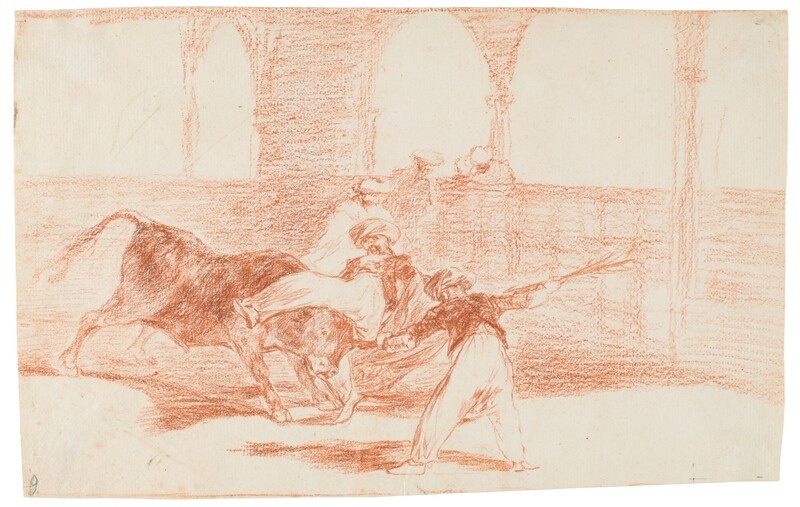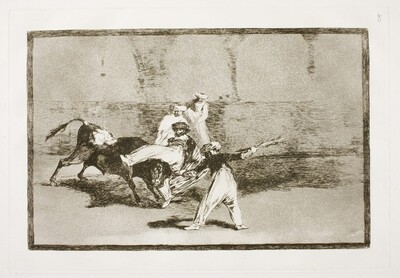- Cronología
- Ca. 1814 - 1816
- Ubicación
- The Prado National Museum. Madrid, Madrid, Spain
- Dimensiones
- 189 x 298 mm
- Técnica y soporte
- Sanguine on laid paper
- Reconocimiento de la autoría de Goya
- Documented work
- Titular
- El Prado National Museum
- Ficha: realización/revisión
- 01 Oct 2021 / 22 Jun 2023
- Inventario
- D4389
9 [reworked](in pencil; recto, lower left-hand corner)
Espagnole chargée de pourvoir aux besoins de l' Armée. Sortie. 36 [2nd support] (in pencil; recto, upper part)
Engraving with slight differences [Under the annotation made in pen] (verso, upper part)
214 (verso, upper left)
Entrée. Ordre Genéraux de Versement [2nd support] (in pen; verso, upper part)
Watermark: [Large St. Andrew's cross with letters "HONIG" between vegetal scrolls with a flower above, and below the letters "J H & Z"].
See How the ancient Spaniards hunted bulls on horseback in the countryside.
Javier Goya, Madrid, 1828; Mariano Goya, Madrid, 1854; Valentín Carderera, Madrid, c. 1861; Mariano Carderera, Madrid, 1880; Prado Museum, 1886.
See How the ancient Spaniards hunted bulls on horseback in the countryside.
Preparatory drawing of the print Catching of a Moor in the square depicts a bullfight, which is not without its comicality due to the unusual costumes of the figures.
According to Matilla, Goya refers to the bullring as the theatrical atmosphere of the bullfights; the blurred natural backgrounds here become a real architectural setting with semicircular arches and columns, to which he adds the bullfighting ring. Vaulted architecture is a common feature of the artist's work, a scenic space for tragic events, and the present image therefore has a deeper meaning than the merely festive. Goya attempts to emphasise the vastness of the zaragüelles by means of light effects, making them stand out against the dark background that surrounds them.
Lafuente Ferrari pointed out a certain similarity between the background of this preparatory drawing and a design of the work Transporting the Wounded to the Hospital from the Disasters of War series that was never recorded, which shows arches that form a setting similar to the scene in question, where the human drama of death is depicted.
-
Roma D.Anderson: Editeur1908pp. il. CXII
-
1946p. 191
-
MadridMuseo del Prado1954n. 157
-
ParísLe Club Français du Livre1963p. 62
-
Vie et ouvre de Francisco de GoyaParísOffice du livre1970p. 277, nº 1164
-
Barcelona1974pp. 6, 12
-
Dibujos de Goya, 2 volsBarcelonaNoguer1975pp. 344-345, nº 247
-
MadridMuseo Nacional del Prado2001pp. 53-54, [142]

